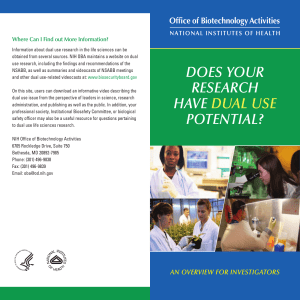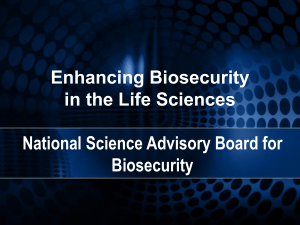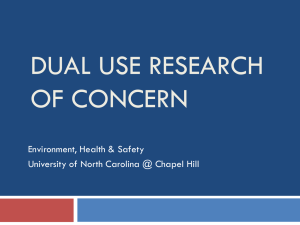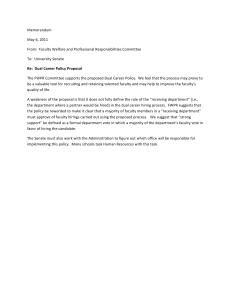N S A
advertisement
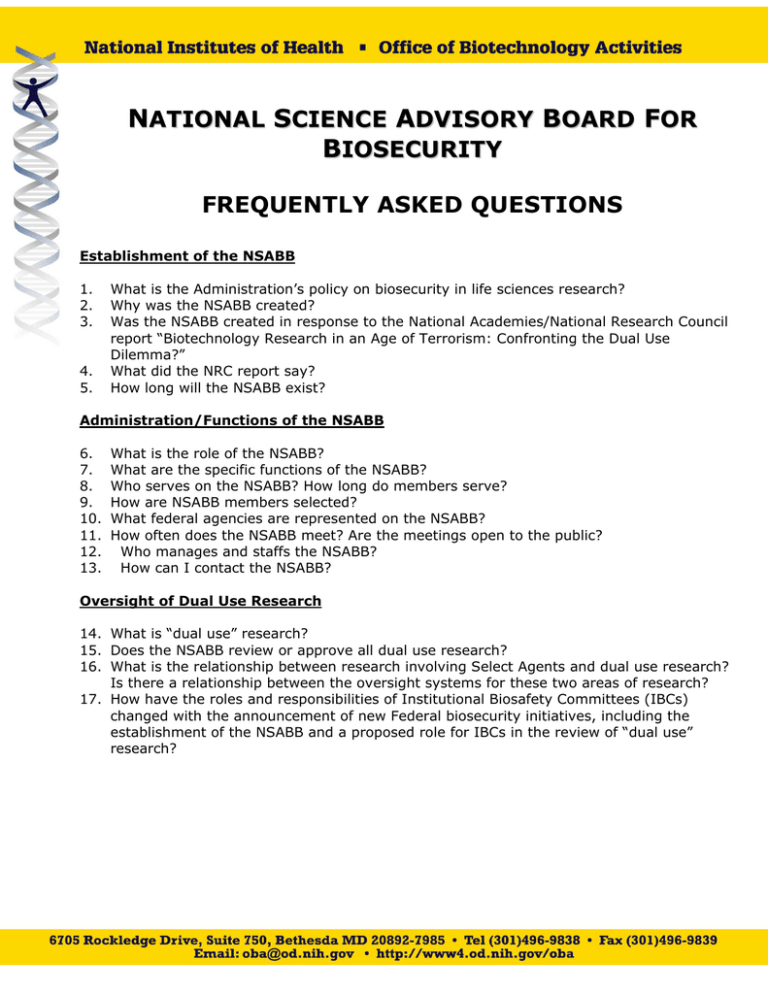
NATIONAL SCIENCE ADVISORY BOARD FOR BIOSECURITY FREQUENTLY ASKED QUESTIONS Establishment of the NSABB 1. 1. 2. 2. 3. 3. 4. 4. 5. 5. What is the Administration’s policy on biosecurity in life sciences research? Why was the NSABB created? Was the NSABB created in response to the National Academies/National Research Council report “Biotechnology Research in an Age of Terrorism: Confronting the Dual Use Dilemma?” What did the NRC report say? How long will the NSABB exist? Administration/Functions of the NSABB 6. 6. 7. 7. 8. 8. 9. 9. 10. 11. 12. 13. What is the role of the NSABB? What are the specific functions of the NSABB? Who serves on the NSABB? How long do members serve? How are NSABB members selected? What federal agencies are represented on the NSABB? How often does the NSABB meet? Are the meetings open to the public? Who manages and staffs the NSABB? How can I contact the NSABB? Oversight of Dual Use Research 14. What is “dual use” research? 15. Does the NSABB review or approve all dual use research? 16. What is the relationship between research involving Select Agents and dual use research? Is there a relationship between the oversight systems for these two areas of research? 17. How have the roles and responsibilities of Institutional Biosafety Committees (IBCs) changed with the announcement of new Federal biosecurity initiatives, including the establishment of the NSABB and a proposed role for IBCs in the review of “dual use” research? Establishment of the NSABB 1. What is the Administration’s policy on biosecurity in life sciences research? In addressing national biosecurity needs, the Administration is carefully balancing the importance of continued progress in the life sciences against the need to minimize the risk of misuse of research information to pose a threat to public health and other aspects of national security. This is resulting in a number of proposed policies and activities that collectively aim to enhance biosecurity in life sciences research. The initiatives underway include (1) implementation of the Public Health Security and Bioterrorism Preparedness and Response Act through the Select Agent Program, (2) promotion of research into development of countermeasures for biological threats, (3) establishment of the National Science Advisory Board for Biosecurity (NSABB) to provide guidance on biosecurity in life science research, and (4) a series of biosecurity initiatives on which the NSABB is advising. These initiatives include: Development of a framework for the review and oversight of dual use research of concern at the federal and institutional levels; Criteria for defining dual use research of concern; Guidelines for the publication, public presentation, and public communication of potentially sensitive research; Guidance on developing a code of conduct for scientists and laboratory workers engaged in research activities with dual use potential; Fostering international collaboration on the oversight of dual use biological research; Programs for education and training on the issue of dual use research and related biosecurity measures. 2. Why was the NSABB created? The advisory board was created to provide advice and guidance to the federal government regarding biological research yielding information and technologies with the potential to be misused to pose a biologic threat to public health or national security (i.e., dual use research). The NSABB advises on and recommends specific strategies for the efficient and effective oversight of federally conducted or supported dual use biological research, taking into consideration national security concerns and the needs of the research community. 3. Was the NSABB created in response to the National Academies/National Research Council report “Biotechnology Research in an Age of Terrorism: Confronting the Dual Use Dilemma?” The National Research Council (NRC) report made an important contribution to the development of biosecurity policy, although it was not the only stimulus for these actions. Prior to the release of the NRC report, the Administration had already initiated an examination of security issues in biological research. This executive branch evaluation was in progress when the report was published. The NRC report recommended a series of actions to improve biosecurity in life science research, one of which was the creation of an advisory body. The NSABB, as it is chartered, differs somewhat from the panel proposed by the NRC report, but has aims similar to those envisioned by the NRC committee. 4. What did the NRC report say? The NRC report discussed concerns related to the potential for biotechnology research to be used inappropriately for purposes of biowarfare or bioterrorism. For example, the report addressed a very significant issue facing life scientists, research administrators, policymakers, national security experts, and scientific publishers, namely, how to minimize the potential for misuse of biotechnology without hindering the progress of science and the important benefits that it yields. The report also recommended a series of actions to protect public health and improve research biosecurity. The Administration agrees that there is a need for improved biosecurity within the life sciences research community. The NSABB was established to recommend strategies to avoid unnecessary restrictions on critical life sciences research while addressing national security concerns. 5. How long will the NSABB exist? As with all federal advisory committees, the NSABB is chartered for two year intervals and will continue its work pending biannual renewals of the charter by the Department of Health and Human Services (HHS). Administration/Functions of the NSABB 6. What is the role of the NSABB? The NSABB advises all federal departments and agencies with an interest in life sciences research. The Board recommends specific strategies for the efficient and effective oversight of dual use biological research, including the development of guidelines for institutional review of dual use research. The Board considers both national security concerns and the needs of the research community when providing guidance and recommendations to the federal government. 7. What are the specific functions of the NSABB? The initial tasks of the Board included development of criteria for the identification of dual use research; tools for the communication of dual use research results and technologies; and guidance on developing a code of conduct for scientists and laboratory workers that can be adopted by federal agencies, as well as by professional organizations and institutions engaged in conducting life science research. In addition, the NSABB will advise on a number of other issues, including oversight of dual use research, biosecurity training and education for scientists; strategies to foster international dialogue on issues pertinent to dual use biological research; and any other issues as directed by the Secretary of HHS. 8. Who serves on the NSABB? How long do members serve? The NSABB has 25 voting members representing key stakeholder perspectives and 18 ex officio members representing various federal agencies. Members serve for overlapping terms of one to four years. The NSABB members provide expertise in areas such as molecular biology, microbiology, infectious diseases, laboratory biosafety and biosecurity, public health/epidemiology, health physics, pharmaceutical production, veterinary medicine, plant health, food production, bioethics, national security, biodefense, intelligence, law and law enforcement, scientific publishing, institutional biosafety committees, recombinant DNA, and export control. 9. How are NSABB members selected? The NSABB members are appointed by the Secretary of HHS in consultation with other federal departments and agencies with an interest in life sciences research. The public can submit nominations for future NSABB membership through the ex officio agencies or directly to the Office of Biotechnology Activities (OBA) at nsabb@od.nih.gov. 10. What federal agencies are represented on the NSABB? The Board includes nonvoting ex officio members from relevant federal departments and agencies with an interest in life sciences research. These include: Executive Office of the President Department of Health and Human Services Department of Energy Department of Homeland Security Department of Veterans Affairs Department of Defense Department of the Interior Environmental Protection Agency U.S. Department of Agriculture National Science Foundation Department of Justice Department of State Department of Commerce National Aeronautics and Space Administration Intelligence Community Others as appropriate 11. How often does the NSABB meet? Are the meetings open to the public? The NSABB meets at least twice a year, and may also be convened on an as-needed basis. All meetings of the NSABB are announced in the Federal Register and on the NSABB web site at www.biosecurityboard.gov. NSABB meetings are open to the public, except as determined otherwise by the Secretary of HHS, in accordance with the Sunshine Act (5 U.S.C. 552b(c)) and the Federal Advisory Committee Act. 12. Who manages and staffs the NSABB? The HHS Secretary designated the National Institutes of Health (NIH) to provide management and support services for the NSABB. The NSABB staff is located in the Office of Biotechnology Activities (OBA) within the Office of the Director, NIH. 13. How can I contact the NSABB? You may contact NSABB through the NIH Office of Biotechnology Activities at 301-496-9838 or by email at nsabb@od.nih.gov. General information about NSABB, such as its membership and upcoming meeting dates, can be accessed on the NSABB Web site at www.biosecurityboard.gov. Oversight of Dual Use Research 14. What is “dual use” research? The NSABB has proposed defining “dual use research of concern” as research that, based on current understanding, can be reasonably anticipated to provide knowledge, products, or technologies that could be directly misapplied by others to pose a threat to public health, agriculture, plants, animals, the environment, or materiel. The NSABB has also proposed a series of experimental outcomes that should be given special consideration for their dual use potential. The public will be invited to comment on this definition, and then the U.S. government will consider whether and how to adopt this definition as formal policy. 15. Does the NSABB review or approve all dual use research? No. The NSABB advises on the development of national policies governing institutional review and approval of dual use biological research. The Board will also develop criteria and processes for institutions to refer classes of research or specific experiments to the NSABB for guidance. Upon referral, the NSABB may review and provide guidance on experiments that exemplify a notable or novel category of dual use research requiring additional guidance from the Board. The NSABB will also advise on the interpretation and application of federal guidelines on dual use research in instances where the institution seeks additional advice. The NSABB does not approve the conduct of specific experiments. 16. What is the relationship between research involving Select Agents and dual use research? Is there a relationship between the oversight systems for these two areas of research? The oversight system for dual use research is likely to be complementary to that of Select Agents in that it will be based on principles and practices for reducing the likelihood that biological organisms, knowledge, and technologies are intentionally misused to pose a risk to public health and national security. Select Agent research is a very specific subset of life sciences research; it involves only those microorganisms and toxins specifically identified in DHHS and USDA regulations as having the potential to pose a severe threat to human, animal, or plant health, or to animal and plant products. All research conducted in the U.S. involving Select Agents, regardless of funding source, is subject to the Select Agent regulations promulgated by DHHS and USDA. These regulations establish requirements regarding the possession, use, and transfer of Select Agents and toxins, including requirements for registration, security risk assessments, safety plans, security plans, training, transfers, record keeping, inspections, and notifications. The criteria for dual use research apply to a much broader category of life sciences research, although they may incorporate certain research projects that involve Select Agents, depending on the nature of the particular experiments and the potential for misuse of the results and/or technology. 17. How have the roles and responsibilities of Institutional Biosafety Committees (IBCs) changed with the announcement of new Federal biosecurity initiatives, including the establishment of the NSABB and a proposed role for IBCs in the review of “dual use” research? At this time, the roles and responsibilities of IBCs have not changed. IBCs should continue to carry out the duties outlined in the NIH Guidelines for Research Involving Recombinant DNA Molecules. The NSABB has developed draft criteria to distinguish dual use research and will embark upon a process of developing guidelines that may eventually define a role for local review groups, such as IBCs, in the oversight of dual use research. IBCs and other stakeholders will have a voice in the development of these guidelines. The IBC community will be notified directly of any future changes in their responsibilities. Also, any relevant developments will be posted on the IBC pages of the Web site of the NIH Office of Biotechnology Activities: http://www4.od.nih.gov/oba/IBC/IBCindexpg.htm.
